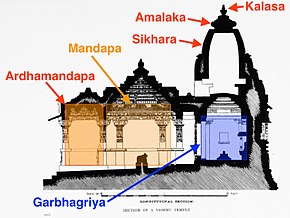
Back عمارة المعبد الهندوسي Arabic হিন্দু মন্দিরের স্থাপত্য Bengali/Bangla Arquitectura de los templos hinduistas Spanish Architecture des temples hindouistes French אדריכלות מקדשים הינדואים HE हिन्दू मन्दिर वास्तुकला Hindi Hindu templomépítészet Hungarian Architettura dei templi indù Italian ಹಿಂದೂ ದೇವಾಲಯ ವಾಸ್ತುಶಿಲ್ಪ Kannada ഹൈന്ദവ ക്ഷേത്ര വാസ്തുവിദ്യ Malayalam
| Part of a series on |
| Hinduism |
|---|
 |

Hindu temple architecture as the main form of Hindu architecture has many different styles, though the basic nature of the Hindu temple remains the same, with the essential feature an inner sanctum, the garbha griha or womb-chamber, where the primary Murti or the image of a deity is housed in a simple bare cell. For rituals and prayers, this chamber frequently has an open space that can be moved in a clockwise direction. There are frequently additional buildings and structures in the vicinity of this chamber, with the largest ones covering several acres. On the exterior, the garbhagriha is crowned by a tower-like shikhara, also called the vimana in the south. The shrine building often includes an circumambulatory passage for parikrama, a mandapa congregation hall, and sometimes an antarala antechamber and porch between garbhagriha and mandapa. In addition to other small temples in the compound, there may be additional mandapas or buildings that are either connected or separate from the larger temples.[1]
Hindu temple architecture reflects a synthesis of arts, the ideals of dharma, values, and the way of life cherished under Hinduism. The temple is a place for Tirtha—pilgrimage.[2] All the cosmic elements that create and celebrate life in Hindu pantheon, are present in a Hindu temple—from fire to water, from images of nature to deities, from the feminine to the masculine, from kama to artha, from the fleeting sounds and incense smells to Purusha—the eternal nothingness yet universality—is part of a Hindu temple architecture.[2] The form and meanings of architectural elements in a Hindu temple are designed to function as a place in which to create a link between man and the divine, to help his progress to spiritual knowledge and truth, his liberation it calls moksha.[3]
The architectural principles of Hindu temples in India are described in the Shilpa Shastras and Vastu Sastras.[4][5] The Hindu culture has encouraged aesthetic independence to its temple builders, and its architects have sometimes exercised considerable flexibility in creative expression by adopting other perfect geometries and mathematical principles in Mandir construction to express the Hindu Way of life.[6]
Hindu temple architecture and its various styles has had a profound influence on the stylistic origins of Buddhist architecture. Aspects seen on Buddhist architecture like the stupa may have been influenced by the shikhara, a stylistic element which in some regions evolved to the pagoda which are seen throughout Thailand, Cambodia, Nepal, China, Taiwan, Japan, Korea, Myanmar, and Vietnam.[7][8]
- ^ These are the usual terms, but there are many variants or different ones in the many Indian languages, ancient and modern.
- ^ a b Stella Kramrisch, The Hindu Temple, Vol 1, Motilal Banarsidass, ISBN 978-81-208-0222-3
- ^ George Michell 1988, pp. 60–61.
- ^ Jack Hebner (2010), Architecture of the Vastu Sastra - According to Sacred Science, in Science of the Sacred (Editor: David Osborn), ISBN 978-0557277247, pp 85-92; N Lahiri (1996), Archaeological landscapes and textual images: a study of the sacred geography of late medieval Ballabgarh, World Archaeology, 28(2), pp 244-264
- ^ BB Dutt (1925), Town planning in Ancient India at Google Books, ISBN 978-81-8205-487-5
- ^ Cite error: The named reference
mmgeometrywas invoked but never defined (see the help page). - ^ Harle, James Coffin (1994). The art and architecture of the Indian subcontinent (2nd ed.). New Haven London: Yale University Press. p. 201. ISBN 978-0-300-06217-5.
- ^ Michell, George (1990). The Penguin guide to the monument of India. The Penguin guide to the monument of India. London: Penguin book. pp. 228–229. ISBN 978-0-14-008144-2.



